About the event
Extreme weather, water, and climate events have become more frequent and severe in the past few years, including winter storms, heatwaves, droughts, tornados, and floods. Most of them did not follow traditional weather patterns, and the latest IPCC report warns us to expect even more occurrences and damaging extremes in the future, exposing notably fragile populations and infrastructures. This stark warning signals that we will need reliable, flexible, and climate-resilient energy infrastructure that can withstand such events.
This event was organized with a diverse range of panelists possessing expertise in scientific, industrial, and technical perspectives, aiming to:
- Identify sources of weather, water, and climate vulnerability, draw lessons from past events, and assess the preparedness of the energy sector to low-carbon and climate-resilient solutions;
- Highlight the strengths of existing and possible future energy systems, including nuclear power plants, against climate change and climate hazards;
- Stress the need for collective mitigation and adaptation strategies to deliver clean energy transitions at speed and scale, and note the opportunity presented by resilient and interconnected power grids, with decentralized options, to deliver decarbonization; and
- Illustrate how recent technologies and scientific advances in weather and climate modeling and forecasting can help electricity players anticipate and adapt to extreme events and, in turn, assuring sustainable and reliable electricity services to the society.
The event was organized by the WMO and contributed by International Atomic Energy Agency (IAEA), International Energy Agency (IEA) and Asian Development Bank (ADB).
Additional Information
- Click here to watch the recorded video
- Click here to see all the WMO Energy-related events at COP26
